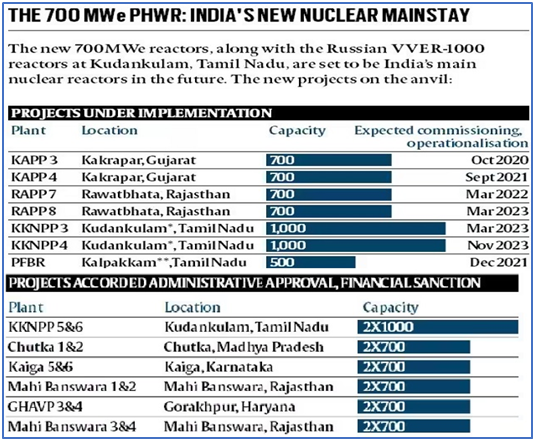Why in news?
- The third unit of the indigenously developed 700-megawatt electric (MWe) nuclear power reactor at the Kakrapar Atomic Power Project (KAPP3) in Gujarat has commenced operations at full capacity.
- The reactor unit had achieved its first criticality – a technical term that signifies the initiation of a controlled, but sustained nuclear fission reaction – in July 2020.
What’s in today’s article?
- Pressurised Heavy Water Reactor (PHWR)
- News Summary
Pressurised Heavy Water Reactor (PHWR)
- About
- The Pressurized Heavy Water Reactor (PHWR) is a type of nuclear reactor used for electricity generation.
- India has been operating several PHWRs for power generation, and these reactors play a significant role in the country's nuclear power program.
- Design and Technology:
- PHWRs are part of the second generation of nuclear reactors and are considered one of the safest reactor designs.
- It commonly uses unenriched natural uranium as its fuel and heavy water (deuterium oxide D2O) as its coolant and moderator.
- The heavy water coolant is kept under pressure, allowing it to be heated to higher temperatures without boiling, much as in a typical pressurized water reactor.
- While heavy water is significantly more expensive than ordinary light water, it yields greatly enhanced neutron economy.
- It allows the reactor to operate without fuel enrichment facilities and generally enhancing the ability of the reactor to efficiently make use of alternate fuel cycles.
- Hence, it mitigates the additional capital cost of the heavy water.
- Safety Features:
- PHWRs are known for their passive safety features.
- The biggest advantage of the PHWR design being the use of thin walled pressure tubes instead of large pressure vessels used in pressure vessel type reactors.
- This results in a distribution of pressure boundaries to a large number of small diameter pressure tubes.
- This lowers the severity of the consequence of an accidental rupture of the pressure boundary than in a pressure vessel type reactor.
- The 700 MWe PHWR design has enhanced safety through dedicated Passive Decay Heat Removal System.
- This system has the capability of removing decay heat (the heat released as a result of radioactive decay) from the reactor core without requiring any operator actions.
- This is on the lines of similar technology adopted to negate the possibility of a Fukushima type accident that happened in Japan in 2011.
- It is also equipped with a steel-lined containment to reduce any leakages and a containment spray system to reduce the containment pressure in case of a loss of coolant accident.
- PHWR in India
- PHWR technology started in India in the late 1960s with the construction of the first 220 MWe reactor, Rajasthan Atomic Power Station, RAPS-1.
- It was built under the joint Indo-Canadian nuclear co-operation.
- The first two units of PHWR using indigenously developed standardised 220 MWe design were set up at the Narora Atomic Power Station.
- To realise economies of scale, the design of 540 MWe PHWR was subsequently developed, and two such units were built at Tarapur.
- Four units of the 700MWe reactor are being constructed at Kakrapar (KAPP-3 and 4) and Rawatbhata (RAPS-7 and 8) site in Rajasthan currently.
- A new fleet of 12 reactors got administrative approval and financial sanction in 2017.

News Summary: Largest indigenously developed N-plant unit in Gujarat starts ops at full capacity
Significance of Kakrapar-3
- A landmark event in India’s domestic civilian nuclear programme
- KAPP-3 is the country’s first 700 MWe (megawatt electric) unit, and the biggest indigenously developed variant of the Pressurised Heavy Water Reactor (PHWR).
- Until now, the biggest reactor size of indigenous design was the 540 MWe PHWR, two of which have been deployed in Tarapur, Maharashtra.
- Boost to energy security
- India is working to ramp up its existing nuclear power capacity of 6,780 MWe to 22,480 MWe by 2031.
- In this context, the 700MWe capacity would constitute the biggest component of the expansion plan.
- Currently, nuclear power capacity constitutes around 2 per cent of the total installed capacity of 4,17,668 MW (May 31, 2023).
- Foundation stone for 900 MWe Pressurised Water Reactor (PWR) of indigenous design
- As the civilian nuclear sector gears up for the next frontier — building a 900 MWe Pressurised Water Reactor (PWR) of indigenous design — the experience of executing the larger 700MWe reactor design will come in handy.
- This is true especially with respect to:
- the improved capability of making large-size pressure vessels, and
- India’s own isotope enrichment plants being developed to supply a part of the required enriched uranium fuel to power these new generation reactors.










